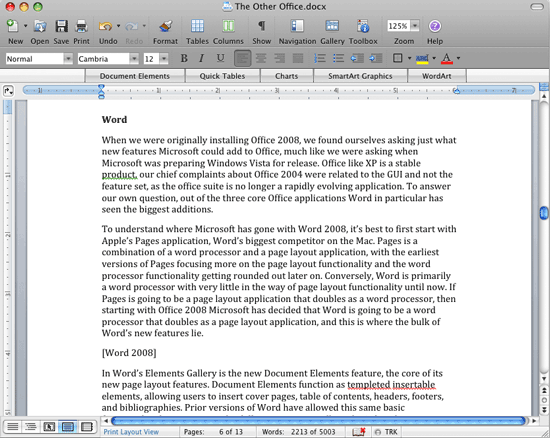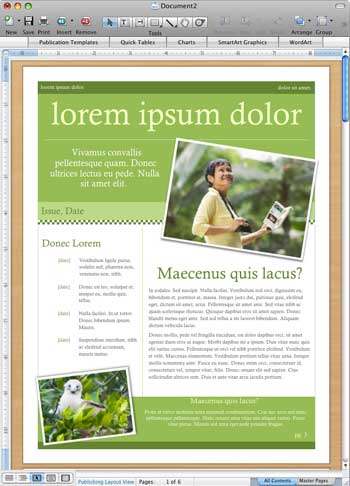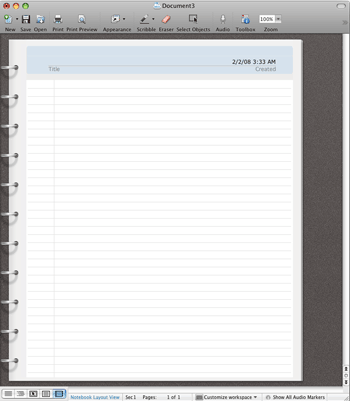The Other Office: Microsoft Office 2008 for Mac Review
by Ryan Smith on February 5, 2008 12:00 AM EST- Posted in
- Mac
Word
When we were originally installing Office 2008, we found ourselves asking just what new features Microsoft could add to Office, much like we were asking when Microsoft was preparing Windows Vista for release. Office like XP is a stable product, our chief complaints about Office 2004 were related to the GUI and not the feature set, as the office suite is no longer a rapidly evolving application. To answer our own question, out of the three core Office applications Word in particular has seen the biggest additions.
To understand where Microsoft has gone with Word 2008, it’s best to first start with Apple’s Pages application, Word’s biggest competitor on the Mac. Pages is a combination of a word processor and a page layout application, with the earliest versions of Pages focusing more on the page layout functionality and the word processor functionality getting rounded out later on. Conversely, Word is primarily a word processor with very little in the way of page layout functionality until now. If Pages is going to be a page layout application that doubles as a word processor, then starting with Office 2008 Microsoft has decided that Word is going to be a word processor that doubles as a page layout application, and this is where the bulk of Word’s new features lie.
In Word’s Elements Gallery is the new Document Elements feature, the core of its new page layout features. Document Elements function as templeted insertable elements, allowing users to insert cover pages, table of contents, headers, footers, and bibliographies. Prior versions of Word have allowed this same basic functionality, but in practice the difference is practically night & day; document elements come in a variety of different styles and most elements can be changed on the fly for another element. This is in stark contrast to previous versions of Word where such functionality is something you could do, but not without a great deal of trouble and with very little visual flair.

With the addition of Document Elements, how Word handles embedded elements has been greatly revised to fit the needs of a page layout application. Word now does a far better job wrapping text around elements, including irregular-shaped and rounded elements. For anyone who has had to struggle with placing an image or chart in to a Word document and getting it to align with the rest of the document correctly, Word 2008 seems to have neatly resolved the issue.

Also finding its way in to the new Elements Gallery to augment the page layout features are the new Quick Tables, a new chart wizard, SmartArt, and WordArt. Quick Tables are pre-built tables featuring different visual styles. The new chart wizard now inserts charts directly as elements and features a slew of brand new styles. SmartArt is a new style of informational art based around various artworks to showcase the relationship between information (think pre-built diagrams); we’ll talk a bit more about it when we’re discussing PowerPoint. And WordArt is as always, WordArt.
Finally, Word introduces two new layout modes. The first mode, Publishing Layout, wraps up the changes to Word to facilitate its emergence as a page layout application. In this mode Word functions more like a true page layout application than a word processor with the focus on creating non-document works (brochures, postcards, etc) through a number of templates and insertable art elements. This layout mode is best described as what would happen if PowerPoint was inserted in to Word, and the end product was something other than a slide. Serious business users will likely ignore this feature along with most of the rest of the new page layout features of Word, but we suspect it will be popular with home users and students.
The other new layout in Word is the Notebook Layout, which turns Word in to a notebook. It’s an interesting concept in theory, and if we had a tablet Mac perhaps we could put it to use, but as it stands right now we’re not sure why Microsoft added it. It’s not a page layout feature, and we can’t find much use for it on its own.
With page layout having been the focus of Word 2008’s
development, very little of the application’s functionality has otherwise
changed. The font crowd will be
happy to find that Word now supports ligatures for fonts for both OpenType and
Apple Advanced Typography fonts.













13 Comments
View All Comments
corporatecookie - Tuesday, February 5, 2008 - link
Remember Outlook 2001 for Mac ..alasknitecrow - Tuesday, February 5, 2008 - link
I find myself using office 2007 a lot more under FusionLocutus465 - Tuesday, February 5, 2008 - link
it seems like office 2007 is built more around extensability through .Net, will '08 for mac support this in lue of VBA? I guess this would require excellent support for .net on the mac platform.